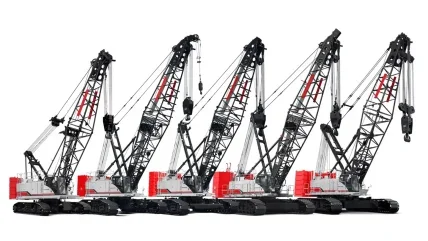
In April 2003 Link-Belt delivered the last of the HTC-11100s, its 100 US ton (90t) truck crane. This summer it begins production of the successor model, the HTC-8690, which is rated at 90 US ton (82t).
The diamond-embossed ‘Boss’ box boom design that has served Link-Belt so well since 1977 has been dropped in favour of the rounded styling seen on the RTC-80100, the three-axle 100 US ton rough terrain that was launched at Conexpo 2002. The boom of the HTC-8690 goes further – it has a single hydraulic cylinder to telescope and a new latching system that Link- Belt has patented.
‘The latching boom brings us a lot of weight saving,’ says Rick Curnutte, Link-Belt’s product manager for telescopic crane. ‘We’ve always used the full powered boom before.’
That weight saving means that the new crane will have a much better chart at larger radii and help it to compete with German all terrains in the 80t to 100t class. Truck cranes, Link-Belt points out, have a significant edge over ATs in roadability in the USA.
Another new feature on the HTC- 8690 is the use of Teflon-impregnated wear pads inside the boom. This means that no greasing is required.
According to the designs, the fivesection formed boom extends to 42.7m (140ft) and maximum tip height is 72.2m (237ft). This is reached with two 4.9m (16ft) lattice inserts between the boom and the fly jib. Onboard tip height is 62.5m (205ft).
The HTC-8690 will also have a new ‘next generation cab’ that is bigger and wider, and has more glass and an eightway adjustable seat. There is also a choice between dual-axis or single-axis joystick controllers along with the 540 Microguard rated capacity limiter. Air conditioning is an option.
The standard modular style counterweight package is 5.32t (11,500 lb) for best roadability but there are options for 12t (26,500 lb) and 14.7t (32,500 lb) to maximise lifting capacity. Counterweight packages are removable for road travel and to optimise weight balance between front and rear axles. The system to raise and lower counterweight is controlled from the operator’s cab.
The HTC-8690 is powered by a 323kW (430hp) Detroit Diesel Series 60, a 12.7- litre engine. It is coupled a ZF’s AS-tronic transmission with 12 forward and two reverse speeds. This transmission, seen already on several German all terrains, provides the benefits of a manual transmission but without a clutch pedal, for travelling up and down steep grades. In addition, it has the controllability of an automatic transmission.
Air-ride suspension is standard on both the front and rear axles of the HTC-8690. This suspension not only provides a smooth highway ride and on-tyre lifting capacities, but it also allows jobsite travel with full 14.7t counterweight.
The winches deliver 7.7t (16,880 lb) of line pull and 146.3m/min (480fpm) of line speed. Spooled onto the winch drum is 20mm diameter rotation resistant wire rope.
Curnutte says that he expects the North American market for this class of truck crane to be about somewhere around 30 or 40 units this year, but it will rise as the overall crane market picks up, he is sure. Prime competition comes from the Grove TMS 900E truck crane.
Link-Belt is confident that it has designed a winner. ‘With the outstanding customer response received to date it is clear that the HTC-8690 is on target to strongly impact this market segment,’ Curnutte says.






